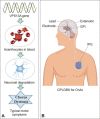Pallidus Stimulation for Chorea-Acanthocytosis: A Systematic Review and Meta-Analysis of Individual Data
- PMID: 35880382
- PMCID: PMC9536914
- DOI: 10.14802/jmd.22003
Pallidus Stimulation for Chorea-Acanthocytosis: A Systematic Review and Meta-Analysis of Individual Data
Abstract
A significant proportion of patients with chorea-acanthocytosis (ChAc) fail to respond to standard therapies. Recent evidence suggests that globus pallidus internus (GPi) deep brain stimulation (DBS) is a promising treatment option; however, reports are few and limited by sample sizes. We conducted a systematic literature review to evaluate the clinical outcome of GPi-DBS for ChAc. PubMed, Embase, and Cochrane Library databases were searched for relevant articles published before August 2021. The improvement of multiple motor and nonmotor symptoms was qualitatively presented. Improvements in the Unified Huntington's Disease Rating Scale motor score (UHDRS-MS) were also analyzed during different follow-up periods. A multivariate linear regression analysis was conducted to identify potential predictors of clinical outcomes. Twenty articles, including 27 patients, were eligible. Ninety-six percent of patients with oromandibular dystonia reported significant improvement. GPi-DBS significantly improved the UHDRS-motor score at < 6 months (p < 0.001) and ≥ 6 months (p < 0.001). The UHDRS-motor score improvement rate was over 25% in 75% (15/20 cases) of patients at long-term follow-up (≥ 6 months). The multiple linear regression analysis showed that sex, age at onset, course of disease, and preoperative movement score had no linear relationship with motor improvement at long-term follow-up (p > 0.05). GPi-DBS is an effective and safe treatment in most patients with ChAc, but no reliable predictor of efficacy has been found. Oromandibular dystonia-dominant patients might be the best candidates for GPi-DBS.
Keywords: Chorea; Chorea-acanthocytosis; Deep brain stimulation; Dystonia; Globus pallidus internus; Individual patient data.
Conflict of interest statement
The authors have no financial conflicts of interest.
Figures



Similar articles
-
An individual patient analysis of the efficacy of using GPi-DBS to treat Huntington's disease.Brain Stimul. 2020 Nov-Dec;13(6):1722-1731. doi: 10.1016/j.brs.2020.09.025. Epub 2020 Oct 8. Brain Stimul. 2020. PMID: 33038596
-
Deep brain stimulation for Huntington's disease: long-term results of a prospective open-label study.J Neurosurg. 2014 Jul;121(1):114-22. doi: 10.3171/2014.2.JNS131722. Epub 2014 Apr 4. J Neurosurg. 2014. PMID: 24702329
-
Pallidal Deep Brain Stimulation in Patients With Chorea-Acanthocytosis.Neuromodulation. 2018 Dec;21(8):741-747. doi: 10.1111/ner.12763. Epub 2018 Apr 10. Neuromodulation. 2018. PMID: 29635714
-
Deep Brain Stimulation of the Globus Pallidus Internus for Secondary Dystonia: Clinical Cases and Systematic Review of the Literature Regarding the Effectiveness of Globus Pallidus Internus versus Subthalamic Nucleus.World Neurosurg. 2021 Oct;154:e495-e508. doi: 10.1016/j.wneu.2021.07.070. Epub 2021 Jul 22. World Neurosurg. 2021. PMID: 34303854
-
Deep brain stimulation in Huntington's disease: a literature review.Neurol Sci. 2021 Nov;42(11):4447-4457. doi: 10.1007/s10072-021-05527-1. Epub 2021 Sep 1. Neurol Sci. 2021. PMID: 34471947 Review.
Cited by
-
Clinical neurophysiology in the treatment of movement disorders: IFCN handbook chapter.Clin Neurophysiol. 2024 Aug;164:57-99. doi: 10.1016/j.clinph.2024.05.007. Epub 2024 May 23. Clin Neurophysiol. 2024. PMID: 38852434 Free PMC article. Review.
-
Bilateral deep brain stimulation (DBS) of globus pallidus internus (GPi) for the treatment of benign hereditary chorea and other childhood onset choreas: a single-center experience.Neurosurg Rev. 2024 Nov 28;47(1):875. doi: 10.1007/s10143-024-03124-2. Neurosurg Rev. 2024. PMID: 39604647
References
-
- Bader B, Walker RH, Vogel M, Prosiegel M, McIntosh J, Danek A. Tongue protrusion and feeding dystonia: a hallmark of chorea-acanthocytosis. Mov Disord. 2010;25:127–129. - PubMed
-
- Liu Z, Liu Y, Wan X, Yang Y, Wang L, Dou W, et al. Pallidal deep brain stimulation in patients with chorea-acanthocytosis. Neuromodulation. 2018;21:741–747. - PubMed
-
- Liu Y, Liu ZY, Wan XH, Guo Y. Progress in the diagnosis and management of chorea-acanthocytosis. Chin Med Sci J. 2018;33:53–59. - PubMed
LinkOut - more resources
Full Text Sources

